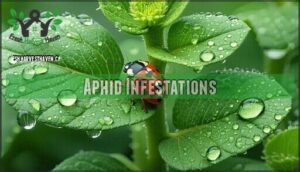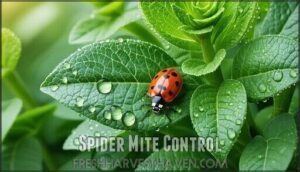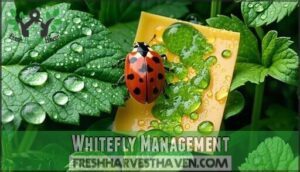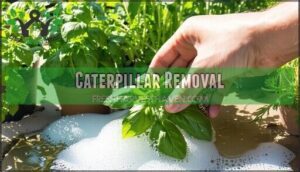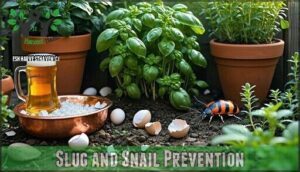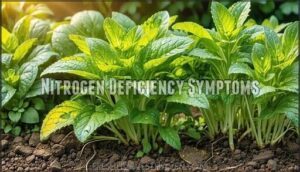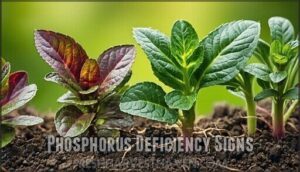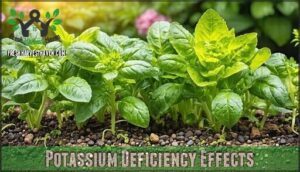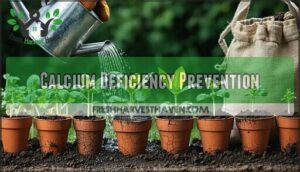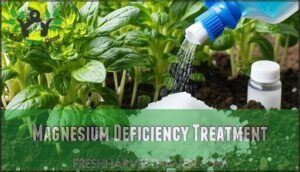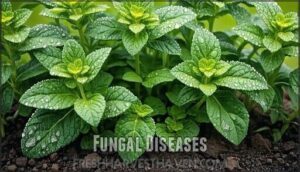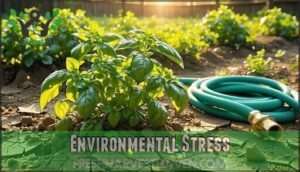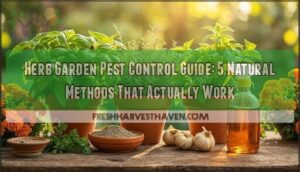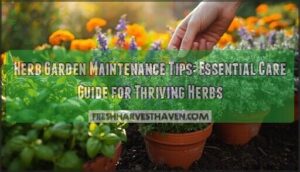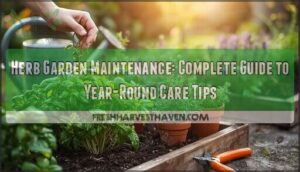This site is supported by our readers. We may earn a commission, at no cost to you, if you purchase through links.
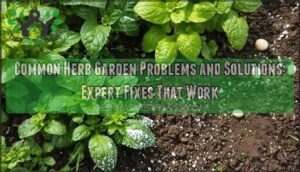
Aphids, spider mites, and slugs love munching on your precious basil and oregano—spray them with soapy water or sprinkle crushed eggshells around plants.
Yellow, droopy leaves usually mean you’re overdoing the watering or your soil lacks nutrients.
Add compost to fix deficiencies and improve drainage with perlite.
Fungal diseases like powdery mildew thrive in humid, crowded conditions, so space plants properly and water at soil level.
Don’t panic when problems arise—most issues have simple fixes once you know what to look for and when to act, and remember to check for clear errors in your gardening techniques, and always keep an eye out for common herb garden problems.
Table Of Contents
- Key Takeaways
- Herb Garden Pests
- Nutrient Deficiencies
- Fungal Diseases
- Environmental Stress
- Garden Maintenance
- Frequently Asked Questions (FAQs)
- What are common garden ailments?
- How do you prevent plant problems?
- How should I care for my herb plants?
- Are slugs damaging your herb garden?
- How should you grow a healthy herb plant?
- How do I protect my herb garden from white flies?
- What herbs should not grow together?
- What do overwatered herbs look like?
- What is killing my herb garden?
- What is the most difficult herb to grow?
- Conclusion
Key Takeaways
- You’ll handle most pest problems with simple natural solutions—spray aphids and spider mites with soapy water, use crushed eggshells around plants for slugs, and encourage beneficial insects like ladybugs for long-term control.
- Watch for yellowing or droopy leaves as signs you’re overwatering or dealing with nutrient deficiencies—fix drainage with perlite, add compost for nutrients, and check soil moisture before watering.
- Prevent fungal diseases like powdery mildew by spacing plants properly for air circulation, watering at soil level instead of on leaves, and removing infected foliage immediately to stop spread.
- Stay ahead of problems with regular maintenance—prune frequently to promote growth, rotate crops annually to break pest cycles, and test soil regularly to catch nutrient issues before they damage your herbs.
Herb Garden Pests
Nothing’s more frustrating than watching tiny invaders munch their way through your carefully tended basil and rosemary, turning your herb garden dreams into a pest’s all-you-can-eat buffet.
Every gardener’s nightmare: waking up to find your prized herbs looking like they hosted an insect feast overnight.
You’ll discover that most herb garden pests can be controlled with simple, natural methods that won’t compromise the safety of your culinary herbs.
Aphid Infestations
Aphids are tiny green vampires that’ll suck the life out of your herbs, leaving behind curled leaves and sticky honeydew that attracts sooty mold.
You’ll spot these pests clustering on tender new growth.
Fight back with soapy water sprays or neem oil for stubborn infestations.
Encourage natural predators like ladybugs to patrol your garden.
Horticultural soaps provide effective insect control without harsh chemicals.
These natural remedies keep your pest control game strong.
Spider Mite Control
Spotting spider mites early makes all the difference in your herb garden’s health.
These tiny troublemakers create fine webbing and yellow stippling on leaves, especially during hot, dry weather.
Spider mites feed by piercing plant cells, causing visible damage.
Your organic pest control arsenal should include:
- Water sprays – Blast mites off with high-pressure water daily
- Neem oil applications for direct contact elimination
- Humidity control – Mist plants regularly to discourage reproduction
- Mite predators – Encourage ladybugs for integrated pest management and biological control
Whitefly Management
While spider mites love dry conditions, whiteflies prefer different environments but cause similar damage.
These tiny white moths cluster under leaves, sucking plant juices and weakening your herbs.
Whiteflies are a persistent pest, especially in greenhouses.
The insects attack globally, impacting various plant types.
Here’s your integrated pest management strategy:
- Deploy sticky traps near affected plants to capture flying adults
- Spread reflective mulches around herb bases to disorient them
- Release ladybugs for natural predators that hunt whitefly nymphs
- Apply insecticidal soap for organic pest control without harsh chemicals
Caterpillar Removal
Nobody likes uninvited guests munching on their herbs, especially hungry caterpillars. Handpicking Caterpillars remains your most effective weapon—simply pluck them off and drop into Soapy Water for instant results.
Barrier Methods like cardboard collars protect vulnerable plants, while Bt Application (Bacillus thuringiensis) offers organic pest control. One preventative measure is to pair basil with tomatoes to deter whiteflies.
Watch for the notorious parsley worm on your parsley and dill.
| Method | Effectiveness | Best For |
|---|---|---|
| Handpicking Caterpillars | 90% | Small gardens |
| Bt Application | 85% | Large infestations |
| Barrier Methods | 75% | Prevention |
| Natural Predators | 80% | Long-term control |
Encourage Natural Predators like birds for sustainable management.
Slug and Snail Prevention
While caterpillars munch from above, slugs and snails attack your herbs from below.
Create effective slug barriers using crushed eggshells or copper tape around plant bases. Habitat removal means clearing debris where these slimy pests hide during daylight hours.
Set up beer traps near affected plants—they’re surprisingly effective bait stations. Manual removal during evening garden walks helps too.
Consider using specialized garden products for persistent infestations. Predator encouragement works wonders; birds and ground beetles naturally control populations while you sleep.
Nutrient Deficiencies
Your herbs can’t tell you they’re hungry, but they’ll show you through yellowing leaves, stunted growth, and lackluster flavor that screams "feed me!".
Nutrient deficiencies are like invisible thieves that rob your garden of its potential, but once you learn to read these plant SOS signals, you’ll have the power to transform struggling herbs into thriving culinary superstars.
You’ll have the power to transform struggling herbs into thriving culinary superstars by learning to read these plant SOS signals, understanding that nutrient deficiencies are a key factor.
Nitrogen Deficiency Symptoms
While pest control keeps bugs at bay, nutrient deficiencies can silently sabotage your herb garden’s success.
Nitrogen deficiency strikes when your soil can’t feed hungry plants properly. You’ll notice older leaves yellow first, followed by stunted growth and lackluster herb development. Don’t ignore these warning signs—they’re your plants crying for help.
Here are five telltale nitrogen deficiency symptoms:
- Older leaves yellow first while newer growth stays green
- Stunted growth with plants remaining smaller than expected
- Poor herb growth with weak, spindly stems
- Yellowing leaves that eventually drop off completely
- Reduced essential oil production affecting flavor and aroma
Regular soil testing reveals nutrient deficiencies before they become serious problems. Once you’ve identified nitrogen shortage, explore fertilizer options like fish emulsion or blood meal. Organic amendments work slower but provide lasting results, feeding your herbs naturally while improving soil structure for future growing seasons.
Phosphorus Deficiency Signs
Spotting phosphorus deficiency in your herb garden isn’t rocket science, but it’ll save your harvest.
This sneaky nutrient shortage weakens plants and cuts yields dramatically.
Here’s what screams phosphorus trouble:
- Leaf Discoloration turning purple or reddish, especially older leaves
- Stunted Growth making herbs look puny and weak
- Root Development problems slowing nutrient uptake
- Reduced Yield from delayed maturity
Fix it with bone meal or soil testing for targeted improvements.
Potassium Deficiency Effects
While phosphorus helps with root development, potassium deficiency creates its own headaches.
You’ll spot Weak Stem Growth and Leaf Edge Yellowing that screams trouble. Poor Herb Growth follows quickly behind these warning signs.
| Symptom | What You’ll See | Quick Fix |
|---|---|---|
| Yellowing leaves | Edges turn yellow-brown | Apply potassium fertilizer |
| Weak stems | Plants flop over easily | Boost Potassium Uptake |
| Stunted growth | Herbs stay small | Use Fertilizer Solutions |
| Poor yields | Less harvest | Address nutrient deficiencies |
| Disease susceptibility | Plants get sick often | Fix herb garden problems |
Don’t let improving growth become a guessing game—tackle potassium issues head-on.
Calcium Deficiency Prevention
Your herbs shouldn’t suffer from calcium deficiency when you’ve got the right game plan.
Unlike potassium issues, calcium problems stem from poor soil conditions and inconsistent watering practices.
Here’s your prevention toolkit:
- Test soil pH regularly – Keep it between 6.0-7.0 for ideal calcium absorption
- Apply gypsum – This calcium source works without altering your soil pH
- Maintain consistent moisture – Erratic watering disrupts calcium uptake completely
- Add organic compost – It provides slow-release calcium while improving soil structure
Consistent watering practices prevent most blossom end rot cases before they start.
Magnesium Deficiency Treatment
While calcium keeps your herb plants structurally sound, magnesium deficiency creates its own headaches.
You’ll spot yellowing leaves with green veins – your plants are basically waving a white flag.
Here’s your rescue plan:
Immediate magnesium boost
Rapid plant recovery
Start with Epsom salt foliar sprays for quick relief.
Mix one tablespoon per gallon of water and spray leaves early morning.
For lasting results, adjust soil pH with organic amendments like compost.
Chelated magnesium works faster than regular supplements, giving your herbs the green comeback they deserve.
Fungal Diseases
You’ve balanced your soil nutrients perfectly, but now fuzzy white patches and wilting stems are crashing your herb party like uninvited guests.
Fungal diseases affect about 35% of herb gardens during humid conditions, but don’t worry—these sneaky plant problems have straightforward solutions that’ll get your herbs back to thriving.
Root Rot Prevention
Your herb garden’s biggest enemy lurks beneath the surface—root rot turns healthy plants into mushy disasters.
Prevent this fungal nightmare with smart soil drainage and careful watering practices.
- Create well-draining soil by mixing perlite or coarse sand into your potting mix
- Check soil moisture before watering—stick your finger two inches deep
- Improve drainage with raised beds or containers with multiple drainage holes
- Avoid overwatering by watering deeply but less frequently
- Repot annually to refresh soil and inspect roots for early fungal issues
Powdery Mildew Control
That white dusty coating on your herb leaves isn’t fairy dust—it’s powdery mildew wreaking havoc.
Combat this sneaky fungal disease with resistant varieties and organic fungicides like baking soda or milk spray.
Boost air circulation by spacing plants properly and pruning overcrowded areas. Water at soil level, not on leaves.
Consider using a suitable mildew treatment for severe cases.
Regular sanitation practices, including removing infected foliage immediately, prevent spread and keep your herbs thriving beautifully.
Downy Mildew Treatment
You’ll often notice downy mildew sneaking up as yellow spots that quickly spread across herb leaves.
Airflow importance can’t be overstated—prune overcrowded areas and space plants properly.
Choose resistant varieties when possible, practice morning watering to let leaves dry, and apply organic fungicides like copper-based solutions.
Consistent disease prevention beats reactive treating diseases every time for effective disease management.
For a natural solution, consider neem oil treatments.
Rust Prevention
Rust spreads like gossip in a crowded garden—fast and unwelcome.
Air circulation keeps leaves dry, so space your herbs properly. Choose resistant varieties when possible and avoid wetness on foliage.
Apply sulfur application early in the season for prevention. If rust appears, organic fungicides work well.
Good sanitation practices and removing affected leaves stop fungal diseases from spreading. Disease prevention beats treatment every time!
Southern Blight Management
Looking at this next challenge, Southern blight can devastate your herb garden if left unchecked. This stubborn fungal disease thrives in warm, moist conditions and attacks plant stems at soil level.
Here’s your battle plan against this garden villain:
- Crop rotation breaks the disease cycle—don’t plant susceptible herbs in the same spot yearly
- Soil solarization uses sun’s heat to kill pathogens lurking in your beds
- Resistant varieties give you a head start against infection
- Sanitation practices remove infected debris before spores spread
- Biological controls introduce beneficial microorganisms that outcompete harmful fungi
Environmental Stress
You’ve battled fungal diseases, but now your herbs face a different enemy: environmental stress that can turn your thriving garden into a wilted mess faster than you can say "basil."
From drowning your plants with too much love (aka overwatering) to watching them bake in scorching heat, environmental factors can reduce your herb’s essential oils by nearly half and leave you wondering why your once-happy garden looks more like a plant emergency room.
Overwatering Prevention
Your herbs are drowning, not thriving! Check soil moisture before watering—stick your finger two inches deep.
Watering frequency matters more than amount. Use well-draining soil and containers with drainage holes to prevent root rot.
Add mulch around plants to retain proper moisture levels. Moisture monitoring keeps root health strong while preventing overwatering.
For ideal results, consider watering in morning to minimize evaporation. Your herbs need oxygen, not swimming pools!
Soil Drainage Improvement
Poor soil drainage turns your herb garden into a swamp, inviting root rot.
Mix horticultural grit or perlite addition into heavy clay soil for better flow. Raised beds solve drainage headaches while compost amendment improves soil health.
Adjust your watering practices—check if water pools after rain. When watering herbs, soggy roots spell disaster, but well-draining soil keeps them thriving.
Sunlight Requirements
Understanding ideal exposure is key to herb garden success.
Most herbs crave full sun with 6-8 hours daily sun duration, while shady herbs like parsley and mint handle partial shade gracefully.
Smart herb placement prevents stunted growth from insufficient light intensity.
You’ll need shade cloths in scorching climates to protect delicate leaves.
Monitor sun exposure patterns and adjust accordingly for thriving plants, ensuring full sun conditions are met for optimal growth.
Temperature Control
Beyond proper lighting, temperature control becomes your next line of defense against heat stress and frost damage.
Shade cloths shield herbs from scorching summer sun, while frost protection covers guard against winter’s bite.
Greenhouses create stable microclimates year-round.
Pot relocation lets you move tender plants to safer spots, acting as a climate buffer against nature’s mood swings.
Humidity Management
Humidity management starts where temperature control ends—keeping your herbs comfortable in muggy conditions.
You’ll need proper air circulation to prevent stagnant moisture that breeds fungal diseases.
Install fans or open vents regularly.
Indoor herbariums benefit from dehumidifiers when humidity climbs above 60%.
Monitor moisture levels weekly—your herbs will thank you by staying healthy instead of developing downy mildew or root rot.
Garden Maintenance
Your herb garden’s long-term success depends on smart maintenance practices that prevent problems before they start.
By establishing regular pruning schedules, rotating crops wisely, and encouraging beneficial insects, you’ll boost your harvest by up to 50% while cutting down on pest headaches and disease drama.
Regular Pruning
Three simple cuts can transform your struggling herb garden into a thriving paradise.
Regular pruning prevents overgrowth while boosting plant health naturally.
When you trim strategically, you’ll promote growth and increase yield by redirecting energy to fresh leaves.
Consider mulching for soil protection to retain moisture.
Master these herb pruning techniques:
- Pinch flower buds early to keep leaves tender and flavorful
- Remove yellowing stems weekly to improve health and prevent disease spread
- Harvest frequently using sharp scissors for better herb harvesting tips
This herb garden maintenance approach keeps plants bushy and productive all season long.
Crop Rotation
Crop rotation’s your secret weapon against recurring garden headaches.
Moving herb families to different spots annually breaks pest cycles and prevents plant diseases from taking root.
Don’t plant basil where last year’s oregano grew—they’re cousins who share similar vulnerabilities.
This simple planning strategy boosts soil health while delivering impressive pest control benefits.
Rotation Benefits Soil Health
Companion Planting
Smart companion planting transforms your herb garden into a self-supporting ecosystem.
Strategic pairings deliver multiple benefits:
- Pest Deterrence – Marigolds repel aphids while basil protects tomatoes
- Growth Enhancement – Tall herbs shade heat-sensitive varieties
- Space Maximization – Vertical companions support climbing plants
- Flavor Improvement – Herb compatibility enhances essential oil production
Pollinator attraction increases naturally when you combine aromatic herbs with flowering companions.
Beneficial Insect Encouragement
Boosting your herb garden’s natural defenses starts with attracting ladybugs and praying mantises—nature’s pest control squad.
Create diverse habitats by planting native flowering herbs like dill and fennel alongside your culinary favorites.
Skip the pesticides; they’ll chase away these beneficial insects faster than you can say "aphid invasion."
Your reward? A thriving garden where biological control handles pest problems while supporting pollinator attraction through integrated pest management.
Frequently Asked Questions (FAQs)
What are common garden ailments?
Your herb garden faces pests like aphids and spider mites.
Diseases such as powdery mildew and root rot are also a concern.
Plus, environmental stress from overwatering, poor drainage, and nutrient deficiencies that’ll stunt growth.
How do you prevent plant problems?
Prevention starts with proper soil drainage and regular monitoring.
You’ll want to space plants correctly, water at soil level, and encourage beneficial insects.
Test your soil annually and prune regularly to keep problems at bay.
How should I care for my herb plants?
Water when topsoil feels dry, provide 6-8 hours of sunlight daily, and prune regularly to encourage bushy growth.
Use well-draining soil, harvest in mornings for peak flavor, and watch for yellowing leaves indicating overwatering.
Are slugs damaging your herb garden?
Check for silvery slime trails and irregular holes in leaves—classic slug calling cards.
You’ll spot them hiding under mulch or pots during daylight.
Create barriers with crushed eggshells or copper tape around vulnerable plants.
How should you grow a healthy herb plant?
Like nurturing a friendship, growing healthy herbs requires consistent care and attention.
Choose well-draining soil, provide 6-8 hours of sunlight daily, water when topsoil’s dry, and prune regularly to encourage bushy growth.
How do I protect my herb garden from white flies?
You’ll combat whiteflies by introducing ladybugs, setting up sticky yellow traps, applying reflective mulch around plants, and spraying insecticidal soap weekly.
These tiny pests hate disruption, so consistent action keeps them away, which is why consistent action is crucial.
What herbs should not grow together?
Like feuding neighbors, some herbs clash terribly.
Don’t plant fennel near anything—it’s allelopathic and stunts growth.
Keep mint contained or it’ll overtake everything.
Separate strong herbs like rosemary from delicate ones like basil.
What do overwatered herbs look like?
Overwatered herbs develop yellowing leaves that feel mushy, especially older ones near the base.
You’ll notice wilting despite wet soil, black or brown roots, and a musty smell from soggy conditions.
What is killing my herb garden?
Like the Grim Reaper stalking your prized basil, several culprits might be destroying your herbs.
You’re likely dealing with overwatering, poor drainage, pests like aphids, or fungal diseases thriving in humid conditions.
What is the most difficult herb to grow?
Rosemary’s your toughest challenge.
It’s picky about drainage, hates wet feet, needs sandy soil, and won’t tolerate overwatering.
You’ll struggle with root rot if conditions aren’t perfect, making it notoriously difficult.
Conclusion
Remember, you can’t have your herbs and kill them too—successful gardening means staying one step ahead of trouble.
These common herb garden problems and solutions aren’t mysteries once you understand the basics.
Watch for early warning signs, act quickly when issues arise, and don’t let small problems become big headaches.
Your herbs will reward your vigilance with abundant harvests and rich flavors, and by keeping these fixes handy, you’ll tackle any challenge your garden throws your way, ensuring abundant harvests.
- https://www.sciencedirect.com/science/article/pii/S1499404623005298
- https://www.mayoclinicproceedings.org/article/S0025-6196(11)61279-2/abstract
- https://pmc.ncbi.nlm.nih.gov/articles/PMC1964882/
- https://www.xiahepublishing.com/2835-6357/FIM-2023-00086
- https://nccommunitygardens.ces.ncsu.edu/resources-3/nccommunitygardens-research/

